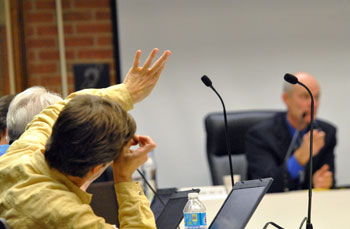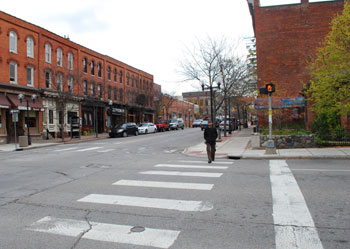Icy sidewalks – including the sidewalk outside Ann Arbor Open – force pedestrians into the street. A woman passing me says, “I’m not risking my neck on those sidewalks!”
Stories indexed with the term ‘pedestrian’
Main btw Huron and Washington
Two pedestrians ascend the mountain of snow piled mid-block in on-street parking space, punch the sky, do not plant flag, continue northbound.
Crosswalk Ordinance Repeal Gets Initial OK
A repeal of the city’s crosswalk ordinance has been given initial approval by the Ann Arbor city council. Action came at the council’s Nov. 18, 2013 meeting on an 8-3 vote. Dissenting were Christopher Taylor (Ward 3), Margie Teall (Ward 4) and mayor John Hieftje. The council will need to vote at a subsequent meeting to give the change final approval.
The city’s ordinance, enacted in 2010 and then revised in 2011, differs from the state’s Uniform Traffic Code (UTC) in two respects: (1) requiring motorists to stop for pedestrians, not just to slow as to yield; and (2) requiring motorists explicitly to take action to accommodate pedestrians standing at the curb at a crosswalk, not just those pedestrians who have … [Full Story]
DDA OKs $250,000 Total for Pedestrian Issues
Pedestrian issues were the subject of two board resolutions passed at the July 3, 2013 meeting of the Ann Arbor Downtown Development Authority.
First, a streetscape framework plan for downtown Ann Arbor will be developed at a cost of $200,000 over the next two years. The resolution allocating the funds states that “an enjoyable pedestrian experience is one of downtown’s principal attractions.”
The $200,000 cost would not cover construction. But according to the board’s resolution, it’s a realistic budget to cover “consultants, contingency, and other related costs.” The idea cited in the resolution is to shorten the planning phases and reduce the costs associated with future streetscape projects. The resolution directs the DDA’s operations committee to create a final project budget and … [Full Story]
Main Street
City attorney taking down license of car that almost hit him in zebra crossing on Main Street.
Ann Arbor Council Handles Green Agenda
Ann Arbor city council meeting (Dec. 17, 2012): The agenda for the council’s final regular meeting of the year was relatively light, but was weighted toward “green” issues – including parks and more general environmental items.

Chart showing projected greenhouse gas emissions if the city of Ann Arbor does nothing, compared to enacting steps outlined in the climate action plan, which was adopted by the city council at its Dec. 17, 2012 meeting.
The council approved two grant applications for future development of at least part of the city-owned property at 721 N. Main St. as a park. It’s seen as an element of a future Allen Creek greenway that would arc northward along the railroad tracks, starting from the East Stadium bridges to the Huron River. The applications were for unspecified amounts from the Michigan Natural Resources Trust Fund (MNRTF) and the Washtenaw County parks & recreation Connecting Communities program. Last year the city received two $300,000 grants from the MNRTF – for the future skatepark at Veterans Memorial Park, and for renovations to the boating facilities at Gallup Park.
The current grant applications came in the general context of an initial recommendation made by a council-appointed task force that has been meeting since the summer. That task force has a much broader geographic charge, which includes the North Main corridor, extending eastward to the Huron River and over to the MichCon property. The task force is due to make recommendations to the council on that broader area by the summer of 2013. However, the group was asked to weigh-in specifically on the 721 N. Main property by the end of this year – because of the grant application deadlines.
The North Main task force had been appointed at the same May 7, 2012 meeting when the council had heard from representatives of 555 Nonprofit Gallery and Studios on the physical survey work necessary for another city-owned property – at 415 W. Washington. At least part of that property is also envisioned as part of a future Allen Creek greenway. After appropriating $50,000 for physical testing at its July 16, 2012 meeting, the council on Dec. 17 allocated another $32,583 after bids came back.
In addition to green space, the council’s Dec. 17 agenda included two “green” resolutions – one that adopted a climate action plan and the other calling on the U.S. Environmental Protection Agency to enforce the Clean Air Act. Ann Arbor’s climate action plan calls for a reduction in greenhouse gas (GHG) emissions of 8% by 2015, 25% by 2025, and 90% by 2050. The reductions are compared to baseline levels measured in the year 2000. The action steps identified in the climate action plan are divided into four main categories: energy and buildings; land use and access; resource management; community and health. Those categories align with the city’s sustainability framework. The plan is also coordinated with a similar effort by the University of Michigan.
Other business handled by the council included another request to the Washtenaw County water resources commissioner’s office in connection with stormwater infrastructure for a street reconstruction project. The petition requested an application for $1.4 million in low-interest loans for a three-year project in the Platt-Packard neighborhood. Also connected to bricks-and-mortar infrastructure was an additional allocation of about $148,000 for the 2012 sidewalk repair and ramp installation program – the first year of a five-year cycle, corresponding to a millage approved by voters in 2011. The total mount of the 2012 sidewalk program was about $965,000.
The council also gave its recommendation to grant a micro brewer license to Biercamp Artisan Sausage & Jerky, a retail shop located at 1643 S. State St.
Initial approval was given by the council for a revision to the city’s ordinance regulating parking on front lawns. The change will make it easier to make arrangements for events other than University of Michigan football games.
And the council approved a $90,000 project budget that will allow for documents to be submitted digitally to the planning and development department. The project includes a public kiosk for reviewing plans.
The council also heard its typical range of public commentary, with topics including pedestrian safety, towing, and Palestinian rights. [Full Story]
Transit Withdrawal Before Council Transition
Ann Arbor city council meeting (Nov. 8, 2012): The post-election meeting of the council – moved from its usual Monday slot to Thursday – featured one high-profile piece of business watched by many throughout the county. That was a vote on withdrawal by the city of Ann Arbor from a new transit authority – called The Washtenaw Ride – which was incorporated on Oct. 3, 2012. The vote to opt out was 10-0. Sandi Smith (Ward 1) was absent.

Margie Teall (Ward 4) raises her hand asking to be recognized so she can speak at the Ann Arbor city council’s Nov. 8 meeting. (Photos by the writer.)
Smith had said her farewell from the council at the previous meeting, on Oct. 15. She had decided not to seek re-election to her seat. At the Nov. 8 meeting, two other councilmembers attended their final meeting – Carsten Hohnke (Ward 5) who, like Smith, did not seek re-election, and Tony Derezinski (Ward 2) who did not prevail in his August Democratic primary. New councilmembers – Sumi Kailasapathy (Ward 1), Sally Petersen (Ward 2) and Chuck Warpehoski (Ward 5) – will be ceremonially sworn in at the start of the council’s next meeting on Nov. 19.
A transitional theme emerged, as discussion of some agenda items straddled the Nov. 8 and Nov. 19 meetings – including the transit authority opt-out vote. Stephen Kunselman (Ward 3) had been planning to bring a similar item forward on Nov. 19, when he felt he’d have a six-vote majority on the question. But that move was preempted by the Nov. 8 item, which included the sponsorship of Sabra Briere (Ward 1), Christopher Taylor (Ward 3) and mayor John Hieftje – who had previously been key figures in supporting the city’s role in the planned authority.
Discussion of a living wage waiver for the nonprofit Community Action Network (CAN) also included mention of the Nov. 19 meeting. That’s when a proposal will be brought forward that would change the living wage ordinance itself. The preference of Hieftje and Hohnke to wait and consider the ordinance revision for all nonprofits – instead of granting a waiver to CAN – was strong enough that they voted against the waiver. But the eight votes it received were enough to ensure that for the next three years, CAN does not need to abide by the living wage ordinance – which would otherwise require it to pay all its workers $13.57/hour.
A resolution that transferred $90,000 from the general fund reserve to the affordable housing trust fund was part of the transitional theme – because it had Sandi Smith’s name attached as a sponsor, even though she could not attend the meeting. The dollar amount was keyed to the price of a strip of land belonging to the former YMCA lot, which the Ann Arbor Transportation Authority recently purchased from the city. The transfer of funds was made in the spirit, if not the letter, of a policy enacted by the council at Smith’s urging at her final council meeting. That policy called for net proceeds of the sale of the Y lot to be deposited in the affordable housing trust fund.
The council’s agenda for Nov. 19 was partially previewed when both Briere and Jane Lumm (Ward 2) announced they’d be bringing forward proposals to revise the city’s Percent for Art ordinance – in the wake of a failed public art millage proposal at the polls on Nov. 6. Briere’s proposal would alter the definition of projects that qualify, while Lumm’s would eliminate the program. The Percent for Art ordinance requires that 1% of the budgets for all capital projects be set aside for public art.
And although he’ll be leaving the council, Derezinski will serve out the remainder of Evan Pratt’s term on the city planning commission. Pratt is leaving that role after being elected Washtenaw County water resources commissioner. At the Nov. 8 meeting, council confirmed Derezinski’s planning commission nomination, which had come at the council’s previous meeting. The council also decided to expand a task force on planning for the North Main corridor to make room for outgoing councilmember Sandi Smith, and appointed her to that group as a citizen member. She’s been serving as the council’s representative.
In other business, a resolution that would have moved toward converting the city’s retirement system to a defined contribution plan – instead of a defined benefit plan – was withdrawn. The council also approved increasing the staffing level of the fire department from 85 to 86 firefighters. And the city’s sign board of appeals (SBA) was dissolved by the council, with responsibilities transferred to the zoning board of appeals (ZBA). The council also voted to give city attorney Stephen Postema a 2.4% raise, his first in five years. [Full Story]
City Council OKs Pedestrian Improvements
Approvals have been given by the Ann Arbor city council for two separate projects featuring pedestrian and non-motorized improvements. One is a Safe Routes to School project on Green Road. And the other involves a Michigan Dept. of Transportation (MDOT) project to install a pedestrian island on Huron Street between Thayer and Ingalls. The action came at the council’s Nov. 8, 2012 meeting.
What the council authorized for the Safe Routes to School project – in connection with Thurston Elementary School – was an agreement between the city and MDOT for the installation of bike and pedestrian safety improvements on Green Road. The agreement is required as a condition of the federal funds used for the project – a total of … [Full Story]
UM Pitches Plan to Close Monroe Street

Yellow: new law school building to be constructed in place of surface parking. Blue: student commons to be renovated. Monroe Street is the road just north of the new law school building. (Click image for larger view.)
Glimpsing through the door of room 116 of Hutchins Hall at UM Law School on Tuesday evening, The Chronicle could see what seemed like a late-evening class in session. Not sure of the room number we wanted, it was with some caution that we nosed further into the room. Ah. The familiar faces of Tony Derezinski, newly elected Ann Arbor city council representative of Ward 2, and Dave … [Full Story]
Column: Waiting Too Long for the Go
The city of Ann Arbor has been installing some new traffic lights around town. Traditional signals display a “Walk” light for as long as 25 seconds. This new type of signal displays a “Walk” light for only four seconds, out of a total cycle of up to 90 seconds. One example of such a signal is the crossing of State Street at Liberty Street downtown. [Full Story]




